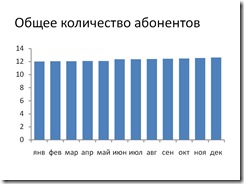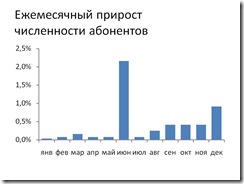The diagram that the pole, as turned - and left
When presenting digital data, one who is well able to build diagrams has a decisive advantage over the fact that he does not know how to do this.
For example, a rather typical case: you need to demonstrate the dynamics of the number of subscribers. Suppose that if the management believes that the dynamics are good, then we will be given a bonus (or at least they will not be fired).
If you just take the number of subscribers and build bars monthly, then we get a picture of a radical stagnation (well, or stability).
')

And it is itching to “pull up” the ordinate axis and start not from scratch to show that the number is still increasing!

Like now, exactly with the same data, the dynamics can be seen. But something is wrong: since the last column is almost twice the size of the first one, the eyes persistently prompt the viewer that the number of subscribers has doubled! This is already a bust - too frank scam, which will surely be revealed, and then there will be no bonus.
But you can also show the increase from zero monthly, cumulative result! Naturally, you have to first convert everything to interest.

Everything is absolutely honest, no cutting of the scale. Although 5%, but it is really clear that things are cheerfully uphill. What you need!
And if you take the issue seriously and really try to show the picture, on the basis of which you can analyze the situation that has developed during the year, you will get this option:

With him, of course, neither the stability of the situation, nor, especially, the unstoppable explosive growth can be shown.
But with such a picture of what is happening, you can really discuss the necessary questions:
Why was there such a deadly calm from February to summer?
»What factors contributed to the fact that growth in June is greater than in the“ high season ”in December?
Why, after this surge in the number of new subscribers, was there such a crushing fall?
But, as you know, for such questions you can make yourself troubles and detractors)))
For example, a rather typical case: you need to demonstrate the dynamics of the number of subscribers. Suppose that if the management believes that the dynamics are good, then we will be given a bonus (or at least they will not be fired).
If you just take the number of subscribers and build bars monthly, then we get a picture of a radical stagnation (well, or stability).
')

And it is itching to “pull up” the ordinate axis and start not from scratch to show that the number is still increasing!

Like now, exactly with the same data, the dynamics can be seen. But something is wrong: since the last column is almost twice the size of the first one, the eyes persistently prompt the viewer that the number of subscribers has doubled! This is already a bust - too frank scam, which will surely be revealed, and then there will be no bonus.
But you can also show the increase from zero monthly, cumulative result! Naturally, you have to first convert everything to interest.

Everything is absolutely honest, no cutting of the scale. Although 5%, but it is really clear that things are cheerfully uphill. What you need!
And if you take the issue seriously and really try to show the picture, on the basis of which you can analyze the situation that has developed during the year, you will get this option:

With him, of course, neither the stability of the situation, nor, especially, the unstoppable explosive growth can be shown.
But with such a picture of what is happening, you can really discuss the necessary questions:
Why was there such a deadly calm from February to summer?
»What factors contributed to the fact that growth in June is greater than in the“ high season ”in December?
Why, after this surge in the number of new subscribers, was there such a crushing fall?
But, as you know, for such questions you can make yourself troubles and detractors)))
Source: https://habr.com/ru/post/51175/
All Articles